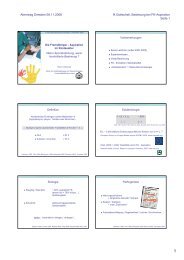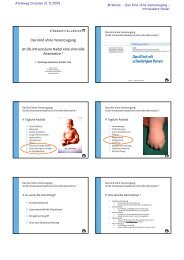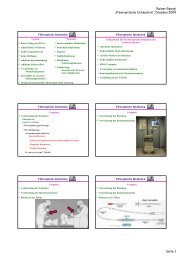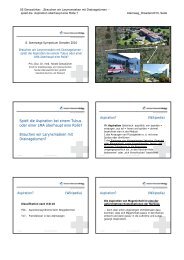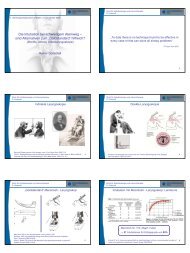Stellenwert der Videolaryngoskopie - Atemweg Uniklinikum Dresden
Stellenwert der Videolaryngoskopie - Atemweg Uniklinikum Dresden
Stellenwert der Videolaryngoskopie - Atemweg Uniklinikum Dresden
Sie wollen auch ein ePaper? Erhöhen Sie die Reichweite Ihrer Titel.
YUMPU macht aus Druck-PDFs automatisch weboptimierte ePaper, die Google liebt.
8. <strong>Atemweg</strong>s-Symposium <strong>Dresden</strong> 2010<br />
<strong>Stellenwert</strong> <strong>der</strong> <strong>Videolaryngoskopie</strong> -<br />
sind damit alle Probleme gelöst?<br />
Ist die „blinde“ Intubation mit einem „Bougie“<br />
obsolet?<br />
Reiner Gottschall
8. <strong>Atemweg</strong>s-Symposium <strong>Dresden</strong> 2010<br />
<strong>Stellenwert</strong> <strong>der</strong> <strong>Videolaryngoskopie</strong> -<br />
sind damit alle Probleme gelöst?<br />
Ist die „blinde“ Intubation mit einem „Bougie“<br />
obsolet?
„Goldstandard“ Macintosh - Laryngoskop<br />
www.adair.at<br />
Macintosh RR A new laryngoscope. Lancet 1943;1, 205<br />
Scott J, Baker PA How did the Macintosh laryngoscope become so popular?<br />
Pediatr Anesth 2009;19 (Suppl.1):24-9
Mo<strong>der</strong>ne <strong>Videolaryngoskopie</strong><br />
DCI<br />
Kaplan MB et al. Comparison of direct and video-assisted views of the larynx during<br />
routine intubation. J Clin Anesth 2006;18:357-62<br />
Dörges V, Serocki G Blick um die Ecke. Notfall- und Intensivmedizin 2009;5:24-6
DCI<br />
(Indirekte) Videolaryngoskope<br />
*auch direkte Laryngoskopie möglich<br />
www.karlstorz.de* www.karlstorz.de* www.saegeling-mt.de<br />
www.truphatek.com<br />
www.surgcomp.com www.airtraq.com<br />
www.b-und-p.com<br />
www.ambu.de<br />
Kaplan MB et al. Seeing is believing: the importance of video laryngoscopy in teaching<br />
and in the managing the difficult airway. Surg Endosc 2006;Suppl 2:S479-83
Videolaryngoskope -<br />
was macht den Unterschied?<br />
□ Nomenklatur / Klassifizierung / Methodik<br />
□ Bildtransmission, -gebung, -verarbeitung<br />
□ Tubusführung, -passage<br />
□ Energie, -Lichtquelle<br />
□ Einweg-, Mehrweginstrument*<br />
□ Bereitstellungszeit<br />
□ Design (Corpus, Spatel)<br />
□ Größenspektrum<br />
□ intuitive Anwendung<br />
□ (Folge-)Kosten, Zubehör<br />
*Muscarela LF Reassessment of the risk of healthcare-acquired infection during<br />
rigid laryngoscopy. J Hosp Infect 2008;68:101-7
Videolaryngoskope / (optische Stilette):<br />
Indikationsspektrum<br />
□ Unerwartet: Cormack & Lehane ≥ Grad 3 („can oxygenate“)<br />
=Plan B<br />
□ Erwartet: - Alternative (Wach-)Intubation<br />
- HWS –Probleme; RSI<br />
=Plan A - Limitierte Mund -Kiefer -Öffnung<br />
- Kritischer (maxillärer) Zahnstatus<br />
□ Sonstige: - Infektionen (z.B. z.B. CJK → Airtraq, Airtraq,<br />
AWS, GLS, McGrath)<br />
- Habituelle Kieferluxation, Stimmberuf<br />
- Umintubation (Tubuswechselkatheter)<br />
- Magen-, TEE-Sondenplatzierung<br />
=Plan A<br />
- Training in Tagesroutine (außer Airtraq)<br />
- Bildgebung und -dokumentation,<br />
dokumentation, E-learning learning, ,<br />
Telemedizin?<br />
McGuire BE, Younger RA Rigid indirect laryngoscopy and optical stylets.<br />
Contin Educ Anaesth Crit Care Pain 2010;10:148-51
Videoclip<br />
C-MAC (d-Blade, Boedeker-Zange) zur<br />
nasotrachealen Intubation<br />
Magill-Zange<br />
♂52J.; Z.n. Kopf-Hals-Tu; elektiv-plastische Versorgung OK; Arné -Score
Indirekte <strong>Videolaryngoskopie</strong>:<br />
Umintubation DLT-ETT / TWK unter Sicht<br />
Videoclip<br />
♂54J.; Mb. Bechterew; intakter Zahnstatus; Mitralklappenersatz / HLM;<br />
C&L 4 (!); DLT-Intub. via Einführhilfe n. Muallem;<br />
Konversion mit C-MAC (d-Blade) + TWK 11 Ch
Videoclip<br />
Erwartet schwieriger <strong>Atemweg</strong><br />
(GlideScope® Cobalt)<br />
bis 90°<br />
Mandrin-<br />
Abwinklung<br />
♂59J.; 105 kg; elektiv; Arné -Score >11; Maskenventilation o.B.;<br />
DL (Macintosh #4, C&L 2B → Fehlintubation); Erstanwendung OA
Indirekte <strong>Videolaryngoskopie</strong>:<br />
Tubuspassage-Probleme I<br />
„blind spot“<br />
□ oropharyngealer Raum↓ (!)<br />
□ potenzielles Trauma rechtsseitig<br />
□ (neue) optische Probleme<br />
□ Anwen<strong>der</strong>kompetenz<br />
Dupanovic M Maneuvers to prevent oropharyngeal injury during orotracheal intubation<br />
with the GlideScope video laryngoscope. J Clin Anesth 2010;22:152-4
Videoclip<br />
Kombination C-MAC (d-Blade) mit FFO<br />
♀22J.; dentogener Abszess; Re-Op.; elektiv; Mundöffnung >3 cm;<br />
Maskenventilation problemlos; extra- und intraorale Inzision
Direkte & indirekte Laryngoskopie:<br />
Tubuspassage - Probleme II<br />
□ Materialeigenschaften<br />
□ Tubusgröße, -design<br />
□ Tubusmanipulation<br />
□ Mandrin -Technik<br />
□ Oropharynxraum<br />
90° Linksdrehung<br />
Levitan RM et al. The complexities of tracheal intubation with direct laryngoscopy and<br />
alternative intubation devices. Ann Emerg Med 2010 (online)
Videoclip<br />
Indirekte <strong>Videolaryngoskopie</strong>:<br />
Tubuspassage - Probleme II<br />
Videoclip<br />
Randell T; Antila H Developments in laryngoscopy and tracheal intubation: videogames and<br />
practical tools. Acta Anaesthesiol Scand 2008;52:3-5<br />
Sharma D Is GlideScope® the best way to intubate? Anesthesiology 2010;113:258-9<br />
Dupanovic M Clinical comparison of two stylet angles for orotracheal intubation with the<br />
GlideScope video laryngoscope. J Clin Anesth 2020;22:352-9
Verifizierung <strong>der</strong> Tubuslage<br />
□ Kapnografie / Kapnometrie<br />
(≥ 4 kPa / 30 mm Hg)<br />
Cave Kreislaufstillstand!<br />
□ (In)direkte Laryngoskopie<br />
□ Flexible Endoskopie via Tubus<br />
Thompson JE, Jaffe MB Capnographic waveforms in the mechanically<br />
ventilated patient. Respir Care 2005;50:100-8<br />
Rudraraju P, Eisen LA Confirmation of endotracheal tube position:<br />
a narrative review. J Intensive Care Med 2009;24:283-92
Videolaryngoskope -<br />
<strong>Stellenwert</strong> in <strong>der</strong> Notfall- und Intensivmedizin?<br />
Sakles JC et al. Optical and video laryngoscopes for emergency airway mangement.<br />
Intern Emerg Med 2008;3:139-43<br />
Bjoernsen LP, Lindsay B Video laryngoscopy in the prehospital setting.<br />
Prehospital Disast Med 2009;24:265-70<br />
Paal P et al. Anaesthesia in prehospital emergencies and in the emergency room.<br />
Resuscitation 2010;81:148-54<br />
Matioc AA et al. The critical airway: The difficult airway in the adult critical care (letter).<br />
Crit Care Med 2009;37:1175-6<br />
Manoach S, Pladino L Manual in-line stabilization for acute airway management of<br />
suspected cervical spine injury: historical review and current questions.<br />
Ann Emerg Med 2007;50:236-245
Pro<br />
<strong>Videolaryngoskopie</strong><br />
beim schwierigen <strong>Atemweg</strong>: Fazit I<br />
→ C&L -Score besser<br />
→ weniger Kraft appliziert (laryngeale Morbidität↓)<br />
→ geringere HWS-Bewegungen<br />
→ hämodynamische Stabilität besser<br />
→ Erfolgsrate (Intubation) höher, weniger Fehlintubationen<br />
→ Zeitaufwand (Intubation) geringer, z.T. auch höher (!)<br />
→ weniger Zusatzmanöver (z.B. BURP, Einführhilfe)<br />
→ Lernkurve steil, Kosten attraktiv (vs. FFO)<br />
→ Kombination mit Einführhilfen o<strong>der</strong> flexibler Fiberoptik<br />
→ primär, auch wach (erwartet), sekundär (unerwartet) nutzbar<br />
→ Potenzial für selektive Indikationen (Patientensicherheit↑)<br />
Cooper RM Is direct laryngoscopy obsolete? Internet Journal of Airway Management 4/2006-7<br />
Butchart AG, Young P The learning curve for videolaryngoscopy. Anaesthesia 2010;65:1145-6<br />
McElwain J, Laffey JG A reply. Anaesthesia 2010;65:1146
<strong>Videolaryngoskopie</strong><br />
beim schwierigen <strong>Atemweg</strong>: Fazit I<br />
Con → Methodik von dir. Laryngoskopie (DL) abweichend<br />
→ Methodik diverser Videolaryngoskope different<br />
→ laryngotracheale Tubusführung und -passage erschwert!<br />
→ auf mediane Spatel-Einführung beschränkt<br />
→ minimale Mundöffnung erfor<strong>der</strong>lich<br />
→ nicht bei rechtsseitiger oropharyngealer Pathologie<br />
→ nicht bei Oxygenationsproblemen<br />
→ Mißerfolge und (neue) Komplikationen möglich<br />
→ Verfügbarkeit in klinischer Praxis beschränkt<br />
Niforopoulou P et al. Video-laryngoscopes in the adult airway mannagement: a topical<br />
review of the literature. Acta Anaesthesiol Scand 2010 (online)
Sind die Algorithmen für das schwierige<br />
<strong>Atemweg</strong>smanagement noch aktuell?<br />
Frova G Do videolaryngoscopes have a new role in the SIAARTI difficult airway management<br />
algorithm? Minerva Anestesiol 2010;76:637-40<br />
Saxena S The ASA Difficult Airway Algorithm: is it time to include video laryngoscopy and<br />
discourage blind and multiple intubation attempts in the nonemergency pathway?<br />
Anesth Analg 2009;108:1052
<strong>Videolaryngoskopie</strong>: Fazit II<br />
□ Ermittlung <strong>der</strong> Lernkurven?<br />
□ Vernachlässigen <strong>der</strong> <strong>Atemweg</strong>s-Evaluierung?<br />
□ Verlernen von DL und FOI?<br />
□ Dokumentations- und Aufklärungs-Standard?<br />
□ was sagt <strong>der</strong> Gutachter?<br />
□ keine abschließende Evidenz (Erfolg + Sicherheit + Komfort)<br />
□ <strong>Stellenwert</strong> im <strong>Atemweg</strong>salgorithmus?<br />
Hilfreiche Alternative zur DL und FFO, jedoch kein Ersatz!<br />
□ Training (am normalen <strong>Atemweg</strong>) möglich<br />
□ hervorragende Rolle beim Teaching
8. <strong>Atemweg</strong>s-Symposium <strong>Dresden</strong> 2010<br />
<strong>Stellenwert</strong> <strong>der</strong> <strong>Videolaryngoskopie</strong> -<br />
sind damit alle Probleme gelöst?<br />
Ist die „blinde“ Intubation mit einem „Bougie“<br />
obsolet?
Was ist ein „Bougie“?<br />
□ endotracheal (tube) introducer (z.B. n. Frova, n. Muallem),<br />
gum elastic bougie (n. Eschmann) → Tubus -Einführhilfen<br />
Hen<strong>der</strong>son J Intubation techniques of the unanticipated difficult direct laryngoscopy:<br />
stylets and introducer. In: Dörges V, Paschen H-R (Hrsg.) Management des<br />
schwierigen <strong>Atemweg</strong>s. Springer 2004, p 294-311<br />
„blind“<br />
□ stylets → Tubus -Mandrins<br />
direkte Sicht<br />
MacIntosh RR An aid to oral intubation. Br Med J 1949;1:28<br />
Hung OR, Stewart RD Intubating stylets. In: Hagberg CA (Ed) Benumof‘s<br />
airway management. 2nd Ed, Mosby Elsevier 2007, p 463-75<br />
□ airway / tube exchange catheters → Tubus -Wechsler<br />
„blind“<br />
Cooper RM Extubation and changing endotracheal tubes. In: Hagberg CA<br />
(Ed) Benumof‘s airway management. 2nd Ed, Mosby Elsevier 2007, p 1166-9
Macintosh RR An aid to oral intubation. Br Med J 1949;1, 28
Tubus - Mandrins und -Einführhilfen<br />
n. Eschmann<br />
www.smiths-medical.com<br />
Portex Einweg<br />
n. Frova<br />
www.cook-d.com<br />
n. Muallem<br />
www.vbm-medical.de<br />
Gataure PS et al. Simulated difficult intubation. Comparison of the gum elastic bougie<br />
and the stylet. Anaesthesia 1996;51:935-8
Abb.: www…<br />
Tubus - Mandrins: Indikationen<br />
□ Armierung von ETT (z.B. RSI, VL)<br />
□ Armierung des DLT (bronchialer Schenkel)<br />
→ direkte Laryngoskopie unter Sicht (C&L 1/2A)<br />
→ Mandrin überragt Tubusende nicht<br />
< 35° “hockey stick”<br />
Levitan RM et al. Stylet bend angles and tracheal tube passage using a straight-tocuff<br />
shape. Acad Emerg Med 2006;13:1255-8
Sog. „blinde“ Mandrin - Technik nicht zu<br />
empfehlen!<br />
Videoclip<br />
C-MAC + D-Blade; C&L 2B; „weiche“ Epiglottis<br />
Ahnefeld FW u. Mitarb. Modifikation des Einführungsmandrins für Trachealtuben.<br />
Anaesthesist 1977;26:204-5
Tubus - Einführhilfen: Indikationen<br />
□ Direkte Laryngoskopie (C&L 2B/3A, Seldinger -Technik)<br />
□ Direkte Laryngoskopie (C&L 1/2A, Support f. tracheale<br />
Tubuspassage)<br />
□ Indirekte Laryngoskopie (Support f. laryngeale Tubuspassage)<br />
n. Eschmann<br />
Portex Einweg<br />
n. Frova<br />
n. Muallem<br />
Detave M et al. Use of the Eschmann´s gum elastic bougie in difficult orotracheal intubation,<br />
an audit over eight years of clinical practice. Ann Fr Anesth Reanim 2008;27:154-7
Laryngoskopie - Score<br />
n. Cormack & Lehane, modif. n. Cook<br />
[Macintosh-Spatel ± äußere Larynxmanöver]<br />
1 Stimmlippen komplett einsehbar<br />
2 (A/B) hintere Stimmlippenregion / Aryknorpel sichtbar<br />
3 (A/B) nur Epiglottis sichtbar - beweglich / fixiert<br />
4 Strukturen 1-3 nicht sichtbar<br />
Cook TM A new practical classification of laryngeal view. Anaesthesia 2000;55:274-9
Laryngoskopie - Score<br />
n. Cormack & Lehane, modif. n. Cook<br />
2B 3A<br />
Cook TM A new practical classification of laryngeal view. Anaesthesia 2000;55:274-9
Portex - Einführung für Trachealtuben<br />
(Eschmann´s „gum elastic bougie“)<br />
Orebaugh SL Atlas of airway management. Techniques and tools.<br />
Lippincott Williams & Wilkins 2007, p 83
Methodik <strong>der</strong> Tubus - Einführhilfen<br />
□ Auswahl nach Größe/Länge/Design/Funktion<br />
□ Gleitmittel verwenden, (in)direkte Laryngoskopie<br />
□ “Bougie” von rechts → mittig u. sanft unter die Epiglottis schieben<br />
□ Einführtiefe beachten, nicht gegen Wi<strong>der</strong>stand vorschieben!<br />
□ Zungengrund -Elevation (z.B. Laryngoskop) vor Tubuspassage<br />
□ “Bougie” halten (2. Person), dann Tubuspassage<br />
□ Ggf. Tubus-Rotation 90° gegen Uhrzeiger-Sinn<br />
□ “Bougie entfernen, Tubuslage kontrollieren, Tubus fixieren<br />
□ Unversehrtheit des “Bougie” prüfen!<br />
Phelan MP Use of the endotracheal bougie introducer for difficult intubations.<br />
Am J Emerg Med 2004;22:479-82<br />
www.AnaesthesiaUK.com
Tubus - Einführhilfen<br />
METTI; 14 CH; C&L 3A; Ass. 2.J.; Erstanwendung + Supervision OA<br />
Muallem MK et al. Muallem endo-tracheal tube introducer (METTI): an aid for the<br />
difficult airway. Middle East J Anesthesiol 2005;18:385-9
Was ist ein „Bougie“?<br />
+ <strong>Videolaryngoskopie</strong><br />
□ endotracheal (tube) introducer (z.B. n. Frova, n. Muallem),<br />
gum elastic bougie (n. Eschmann) → Tubus -Einführhilfen<br />
Hen<strong>der</strong>son J Intubation techniques of the unanticipated difficult direct laryngoscopy:<br />
stylets and introducer. In: Dörges V, Paschen H-R (Hrsg.) Management des<br />
schwierigen <strong>Atemweg</strong>s. Springer 2004, p 294-311<br />
□ stylets → Tubus -Mandrins<br />
=indirekte Sicht<br />
MacIntosh RR An aid to oral intubation. Br Med J 1949;1:28<br />
Hung OR, Stewart RD Intubating stylets. In: Hagberg CA (Ed) Benumof‘s<br />
airway management. 2nd Ed, Mosby Elsevier 2007, p 463-75<br />
=indirekte Sicht<br />
□ airway / tube exchange catheters → Tubus -Wechsler<br />
=indirekte Sicht<br />
Cooper RM Extubation and changing endotracheal tubes. In: Hagberg CA<br />
(Ed) Benumof‘s airway management. 2nd Ed, Mosby Elsevier 2007, p 1166-9
Kombination C-MAC (d-Blade) mit<br />
Einführhilfe n. Muallem<br />
Videoclip<br />
♀57J.; elektiv; Arné -Score >11; Maskenventilation o.B.;<br />
Erstanwendung Assistent 1. J. + Supervision OA
Welche Tubus - Einführhilfe?<br />
Mehrweg?<br />
Einweg?<br />
□ beste Evidenz<br />
□ Hygieneproblem<br />
□ keine Evidenz<br />
□ rel. traumatisch<br />
Cupitt JM Microbial contamination of gum elastic bougies. Anaesthesia 2000;55:466-8<br />
Jackson S Time to switch to disposable bougies. Anaesthesia 2003;58;392<br />
Hodzovic I et al. Evaluation of Frova, single-use intubation introducer, in a manikin.<br />
Comparison with Eschmann multiple-use introducer and Portex single-use introducer.<br />
Anaesthesia 2004;59:811-16<br />
Janakiraman C et al. Evaluation of tracheal tube introducers in simulated difficult intubation.<br />
Anaesthesia 2009;64:309-14
Memo für Tubus - Einführhilfen<br />
□ Hinweise <strong>der</strong> Hersteller kennen und respektieren!*<br />
□ Handhabung sollte am Dummy trainiert werden<br />
(z.B. “Tracheale Klicks”, Tasten am Jugulum, etc)<br />
□ Training am elektiven Patienten bedarf Aufklärung / Einverständnis<br />
□ <strong>Atemweg</strong>sverletzungen selten, jedoch prinzipiell möglich<br />
□ i.d.R. nicht als Tubuswechsler, nicht für Trachealkanülen geeignet<br />
□ Evidenz nur für Einführhilfe n. Eschmann (“Goldstandard”)<br />
□ Daten insgesamt überschaubar für Erwachsene<br />
□ Komplikationsrate höher f. steifere Einführhilfen (Dunkelziffer!)<br />
□ Einwegmaterial bevorzugen bzw. kontrollierte Aufbereitung<br />
*Wilkes AR et al (editorial) Introducing new anaesthetic equipment into clinical practice.<br />
Anaesthesia 2008;63:571-5
Tubus - Mandrins und -Einführhilfen<br />
für Kin<strong>der</strong>?<br />
Bonfils P Difficult intubation in Pierre-Robin children, a new method: retromolar route.<br />
Anaesthesist 1983;32:363-7<br />
Walker RWM The pediatric airway. In: Core topics in airway management.<br />
Cal<strong>der</strong> I, Pearce A (Ed.) , Cambridge University Press 2005, p.127<br />
Semjen F et al. Intubation of infants with Pierre Robin syndrome: the use of<br />
paraglossal approach combined with a gum-elastic bougie in six consecutive cases.<br />
Anaesthesia 2008;63:147-50
Tubus - Mandrins und -Einführhilfen<br />
für Kin<strong>der</strong>?<br />
♂9J.; LKGS; sekundäre<br />
Kieferspalten-Osteoplastik;<br />
McGrath -Erstanwendung;<br />
Ass. 2.J. + Supervision OA
Tubus - Einführhilfen: Fazit<br />
„Bougies“ sind nicht obsolet, …gelten bei direkter Laryngoskopie<br />
als alternative Hilfsmittel v.a. bei C&L 2B/3A* (=Plan B), wenn:<br />
□ Szenario* unerwartet auftritt<br />
□ Alternativen nicht zeitnah verfügbar / notwendig sind<br />
□ Oxygenation möglich / gesichert ist<br />
□ Bedingungen für direkte Laryngoskopie optimiert sind<br />
□ dir. Laryngoskopie -Versuche limitiert bleiben (insgesamt 3)<br />
□ Anwen<strong>der</strong> hinlänglich erfahren ist und<br />
□ methodische Risiken / Grenzen respektiert werden<br />
□ Mandrins nicht als Einführhilfen verwendet werden<br />
→ „Bougies“ Bestandteil von Algorithmen f. schwierigen <strong>Atemweg</strong>
„To date there is no technique found to be effective in<br />
every case or that can solve all airway problems“<br />
FE Agrò, Rom 2009




